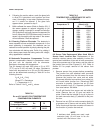
36
MODEL 396R pH/ORP SECTION 7.0
DIAGNOSTICS AND TROUBLESHOOTING
SECTION 7.0
DIAGNOSTICS AND TROUBLESHOOTING
7.1 DIAGNOSTICS AND TROUBLESHOOTING WITH MODEL 54/81/3081 pH/ORP. The Model 54 and 54e
Analyzers and Models 81 and 3081 pH Transmitters automatically search for fault conditions that would cause an
error in the measured pH value, as does the Model 1054A/B pH/ORP Analyzer to a lesser degree. Refer to the
respective manual for a complete description of the analyzer’s fault conditions.
Table 7-1 lists the Analyzer/Transmitters diagnostic messages that indicate a possible sensor problem. A more
complete description of the problem and a suggested remedy corresponding to each message is also listed.
DIAGNOSTIC MESSAGE
54 and 54e
81/3081 DESCRIPTION OF PROBLEM REMEDY
“Calibration Warning” 1. Aged glass. 1. Perform buffer calibration.
2. Sensor not immersed. 2. Be sure electrode measuring tip is in
DBMJcsBtF process.
“Cracked glass failure” Broken or cracked glass. Replace Sensor.
7MBTT!GBJM
“High reference imped” 1. Liquid junction coated. 1. Clean sensor; replace if necessary.
2. Reference Cell gel depleted. 2. Replace sensor.
sFG!GBJM or sFG!WBso 3. Sensor not immersed. 3. Be sure electrode measuring tip is in
process.
“Input voltage high” pH input shorted or sensor. Check wiring. Replace sensor if
“Input voltage low” miswired. necessary.
“Old glass warning” 1. Glass electrode worn out. 1. Replace sensor.
2. Sensor not immersed. 2. Be sure electrode measuring tip is in
7MbTT!WBso
process.
“Reference offset err” Reference electrode poisoned. Replace sensor.
(offline only)
Tte!Fss
“Ref voltage high” 1. Reference shorted or sensor Check wiring. Replace sensor if
“Ref voltage low” miswired. necessary.
2. Sensor not immersed.
“Sensor line open” 1.
Open wire between sensor and analyzer.
1. Check sensor wiring.
2. Interconnecting cable greater than 2. Relocate analyzer.
MJoF!GBJM 1000 ft.
“Sensor miswired” 1.
Open wire between sensor and analyzer.
1. Check wiring.
2. Bad preamplifier. 2. Replace preamplifier.
“Temp error high” 1. Open or shorted RTD. 1. Replace sensor.
“Temp error low” 2. Temperature out of range. 2. Check process temperature.
tFMQ!IJ
tFMQ!MP
TABLE 7-1 Troubleshooting with Diagnostics


















